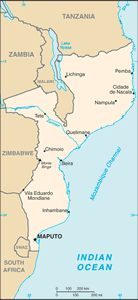The Geography of Mozambique
The Geography of Mozambique
Mozambican Geography
Location: Southeastern Africa, bordering the Mozambique Channel, between South Africa and Tanzania
Geographic coordinates: 18 15 S, 35 00 E
Map references: Africa
Area: total: 801,590 sq km land: 784,090 sq km water: 17,500 sq km
Area - comparative: slightly less than twice the size of California
Land boundaries: total: 4,571 km border countries: Malawi 1,569 km, South Africa 491 km, Swaziland 105 km, Tanzania 756 km, Zambia 419 km, Zimbabwe 1,231 km
Coastline: 2,470 km
Maritime claims: territorial sea: 12 nm exclusive economic zone: 200 nm
Climate: tropical to subtropical
Terrain: mostly coastal lowlands, uplands in center, high plateaus in northwest, mountains in west
Elevation extremes: lowest point: Indian Ocean 0 m highest point: Monte Binga 2,436 m
Natural resources: coal, titanium, natural gas, hydropower, tantalum, graphite
Land use: arable land: 5.43% permanent crops: 0.29% other: 94.28% (2005)
Irrigated land: 1,180 sq km (2003)
Natural hazards: severe droughts; devastating cyclones and floods in central and southern provinces
Environment - current issues: a long civil war and recurrent drought in the hinterlands have resulted in increased migration of the population to urban and coastal areas with adverse environmental consequences; desertification; pollution of surface and coastal waters; elephant poaching for ivory is a problem
Environment - international agreements: party to: Biodiversity, Climate Change, Climate Change-Kyoto Protocol, Desertification, Endangered Species, Hazardous Wastes, Law of the Sea, Ozone Layer Protection, Ship Pollution, Wetlands signed, but not ratified: none of the selected agreements
Geography - note: the Zambezi flows through the north-central and most fertile part of the country


